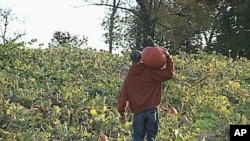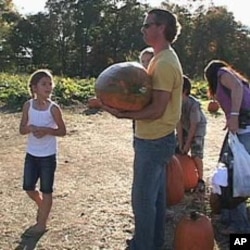Farmers looking for ways to stay profitable are finding a growing source of income in farm tourists.
Especially near urban centers, welcoming visitors is becoming increasingly lucrative while raising crops and livestock are becoming less so.
Autumn is a particularly popular time for farm tourism. This weekend's Halloween celebration of all things scary draws visitors to scenic farms around Washington, DC, to pick pumpkins to carve into jack-o-lanterns.
Pumpkin picking fun
On a recent weekend afternoon, a steady stream of people takes the tractor ride out to the pumpkin patch at Brookfield Pumpkins in Thurmont, MD.
Laine Cliber is here with her brother, sister and parents. She says she is looking for "a tall, orange pumpkin with a long handle." She ends up with a squat, green one with a short handle. But she seems happy with it anyway. The family has a good time in the afternoon sun. They spend more than 70 dollars on four large pumpkins and some smaller gourds.
It has been a good day for Mary Jane Roop, whose family runs the farm. It was a dairy farm until six years ago, when they sold their herd of 300 cows.
Business, weather challenges
Small dairy farms across the country have been shutting down. In about the last 10 years alone, the United States has lost about a third of its dairy farms.
"Many commodities in agriculture have cycles," Roop says, "but this cycle in the dairy industry has been very deep and very long, and it's been very hard on the American dairy farmer."
The Roop family now raises cows for other dairy farms. After getting out of the dairy business, the Roops switched to raising corn and soybeans. But this was a bad year.
"We had a tremendous drought this year. Our corn yields and soybean yields are down substantially," she says.
Pumpkin profits
But the pumpkins thrived in the hot, dry weather.
More importantly, Roop says people want to come pick them.
"The dry weather will affect the crop yields," she says, "but it will not affect the people coming to the farm."
She says pumpkin sales will make up only about 10 percent of the family's income this year. But in a year when other revenue sources are down, every bit helps.
In today's global economy, when farmers face competition from growers overseas, experts say many farmers are finding that welcoming visitors is a good way to help the bottom line.
In addition, urban encroachment on rural areas often puts pressure on farmers to sell their land for development. But some farms near Washington, DC, are capitalizing on the crowds of city folk looking for some fresh air, says Kellie Boles, who runs agriculture development programs for Loudoun County in the neighboring state of Virginia.
"If our wineries are seeing over 400 people on a single day, and our farmers are seeing 3,000 people on a weekend, that's got to be translating into financial benefit for them," Boles says.
Growing business
It's hard to know exactly how big that financial benefit is, but the U.S. Department of Agriculture says farm tourism nationwide was worth about $600 million in 2007. That's nearly triple the figure from 2002.
Boles says the growth comes as increasingly health- and environment-conscious Americans try to learn more about how their agricultural products are raised.
"The kids are going out in the fields and they're picking pumpkins and they're picking apples, and I think it inherently serves as an educational tool to the next generation about where our food does come from," she says.
That makes farm tourism good for the farmers and for the tourists, says Mary Jane Roop.
"We have families that have come back 15 years in a row," she says. "And to us, that says something: That we're meeting a special need for them, and they're meeting a special need for us."
Visitors get to enjoy a fall afternoon in the pumpkin patch. And the Roops get to continue farming.














